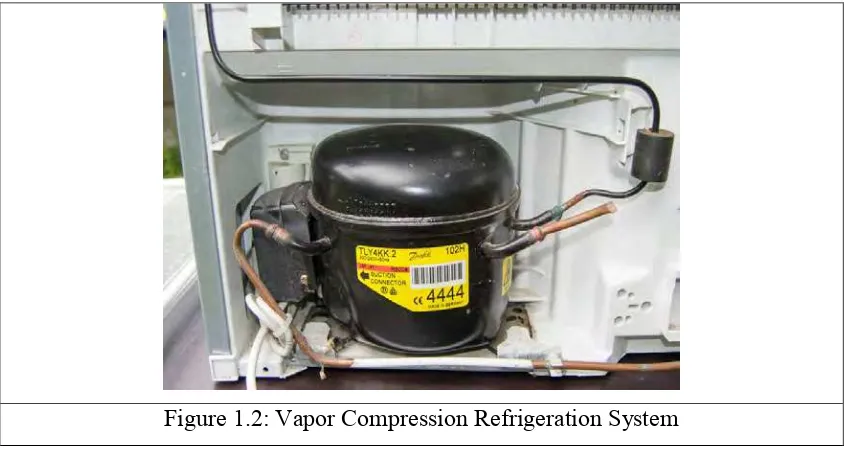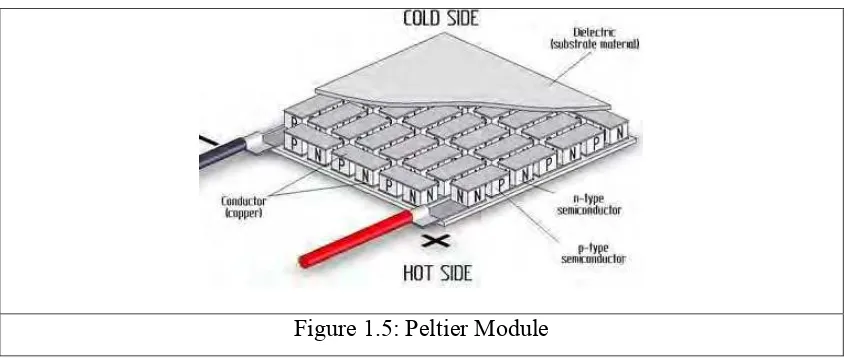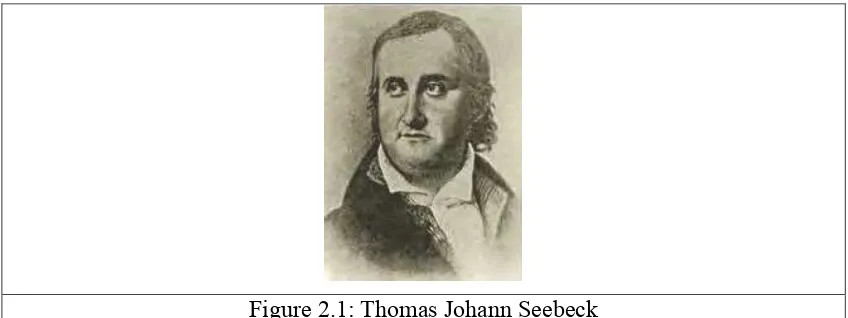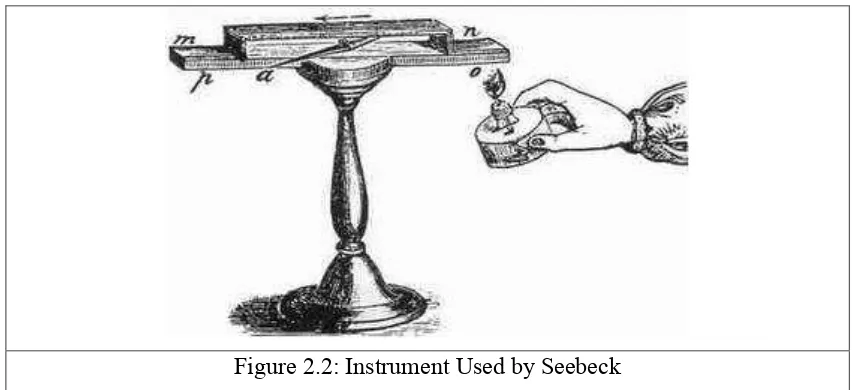UNIVERSITI TEKNIKAL MALAYSIA MELAKA
IMPROVEMENT OF THE EFFICIENCY OF MINI
THERMOELECTRIC REFRIGERATOR BY USING PELTIER
MODULE
This report is submitted in accordance with the requirement of the Universiti Teknikal Malaysia Melaka (UTeM) for the Bachelor of Mechanical Engineering
Technology (Refrigeration and Air-Conditioning Systems) with Honours
by
LEE WEI HAU B071210144 920628-02-5425
UNIVERSITI TEKNIKAL MALAYSIA MELAKA
BORANG PENGESAHAN STATUS LAPORAN PROJEK SARJANA MUDA
TAJUK: Improvement of the Efficiency of Mini Thermoelectric Refrigerator by Using Peltier Module
SESI PENGAJIAN: 2015/16 Semester 1
Saya LEE WEI HAU
mengaku membenarkan Laporan PSM ini disimpan di Perpustakaan Universiti Teknikal Malaysia Melaka (UTeM) dengan syarat-syarat kegunaan seperti berikut:
1. Laporan PSM adalah hak milik Universiti Teknikal Malaysia Melaka dan penulis. 2. Perpustakaan Universiti Teknikal Malaysia Melaka dibenarkan membuat salinan
untuk tujuan pengajian sahaja dengan izin penulis.
3. Perpustakaan dibenarkan membuat salinan laporan PSM ini sebagai bahan pertukaran antara institusi pengajian tinggi.
4. **Sila tandakan ( )
SULIT
TERHAD
TIDAK TERHAD
(Mengandungi maklumat yang berdarjah keselamatan atau kepentingan Malaysia sebagaimana yang termaktub dalam AKTA RAHSIA RASMI 1972)
(Mengandungi maklumat TERHAD yang telah ditentukan oleh organisasi/badan di mana penyelidikan dijalankan)
____________________
iii
DECLARATION
I hereby, declared this report entitled “Improvement of the Efficiency of Mini Thermoelectric Refrigerator by Using Peltier Module” is the results of my own
research except as cited in references.
Signature : ………
Name : ………
iv
APPROVAL
This report is submitted to the Faculty of Engineering Technology of UTeM as a partial fulfillment of the requirements for the degree of Bachelor of Mechanical Engineering Technology (Refrigeration and Air-Conditioning Systems) (Hons.). The member of the supervisory is as follow:
v
ABSTRACT
vi
ABSTRAK
Aktiviti manusia yang melepaskan klorofluorokarbon dan hydrofluorocarbons daripada sistem penyejukan telah memberi kesan negatif kepada alam sekitar. Fenomena ini melahirkan konvensional keperluan untuk membangunkan teknologi penghawa dingin dan penyejukan yang lebih mesra alam dan cekap tenaga. Peti sejuk termoelektrik adalah salah satu peranti yang paling sesuai untuk memenuhi keperluan ini. Peranti ini terdiri daripada modul Peltier sebagai salah satu komponen yang utama. Disebabkan ia tidak mengguna pemampat, peti sejuk termoelektrik mempunyai beberapa kelebihan seperti ringan, mudah diselenggara dan kurang bising berbanding dengan sistem penyejukan yang menggunakan pemampat konvensional. Apabila arus elektrik mengalir ke modul Peltier, bahagian panas modul akan menjadi sangat panas, oleh itu pelepas haba diperlukan untuk melepaskan haba ke persekitaran. Dalam kajian ini, beberapa mini prototaip peti sejuk termoelektrik telah direka dengan menggunakan modul Peltier sebagai komponen yang utama. Kajian ini bertujuan untuk meningkatkan pelepasan haba di bahagian panas modul Peltier untuk mencapai suhu penyejukan yang lebih rendah. Beberapa parameter yang memberi kesan kepada bahagian suhu panas modul Peltier itu telah dikaji. Parameter tersebut ialah suhu persekitaran, bahan-bahan penebat peti sejuk, reka bentuk pelepas haba, arah aliran udara oleh kipas, kuantiti arus elektrik dan kesan bahan perubahan fasa parafin sebagai sumber penyejukan juga telah dikaji. Hasilnya menunjukkan bahawa parameter utama yang mempengaruhi suhu modul Peltier itu ialah kuantiti arus elektrik. Ini disebabkan semakin tinggi arus elektrik dibekalkan, semakin besar perbezaan suhu di antara bahagian panas dan sejuk modul Peltier. Reka bentuk pelepas haba juga ialah parameter yang penting dalam kajian ini. Ia menjadi salah satu komponen yang utama untuk menyebarkan haba dengan cekap. Suhu penyejukan terendah yang dicapai oleh mini peti sejuk ialah 11℃ dan kecekapan tenaga ialah 5.79%. Dengan
vii
DEDICATIONS
viii
ACKNOWLEDGMENTS
First and foremost, I would offer my sincere gratitude to my supervisor Encik Aludin Bin Mohd Serah for his knowledge, understanding and most importantly patience while guiding me. Without his guidance, encouragement and patience, this project would never have been completed on time. For everything you have done for me, Encik Aludin I thank you. I could not have wished for a better adviser, as a teacher and a person.
ix
TABLE OF CONTENTS
DECLARATION ... iii
APPROVAL ... iv
ABSTRACT ... v
ABSTRAK ... vi
DEDICATIONS ... vii
ACKNOWLEDGMENTS... viii
TABLE OF CONTENTS ... ix
LIST OF FIGURES... xiii
LIST OF TABLE ... xv
LIST OF SYMBOLS AND ABBREVIATIONS ... xvi
CHAPTER 1... 1
1.0 Introduction ... 1
1.1 Project Background ... 1
1.2 Problem Statement... 5
1.3 General Objective of Research ... 5
1.3.1 Specific Objectives... 5
1.4 Scope of Research ... 6
CHAPTER 2... 7
x
2.1 A Brief History of Thermoelectric ... 7
2.2 Thermoelectric Coolers ... 10
2.2.1 Peltier Module ... 10
2.2.2 Application of Peltier Module ... 12
2.2.3 Advantages of Peltier Module ... 12
2.2.4 Disadvantages of Peltier Module ... 13
2.3 Thermoelectric Refrigerator ... 13
2.3.1 Internal Components of A Peltier Module ... 14
2.3.2 Thermoelectric Materials ... 15
2.3.3 How Thermoelectric Coolers Work ... 16
2.3.4 Heat Sink ... 17
2.3.4.1 Types of Heat Sinks ... 18
2.4 Phase Change Material (PCM) ... 20
2.4.1 Classification of PCM ... 22
2.4.2 Organic PCM ... 23
CHAPTER 3... 24
3.0 Introduction ... 24
3.1 Overall View of a Mini Thermoelectric Refrigerator... 24
3.2 Prototypes of Mini Thermoelectric Refrigerator ... 26
3.2.1 Prototype 1 ... 26
3.2.2 Prototype II... 27
3.2.3 Prototype III ... 28
xi
3.3.1 Types of Peltier Module ... 29
3.3.1.1 General Specifications of Peltier Module ... 30
3.3.2 Cooling Element... 34
3.3.3 Heat Sink ... 35
3.3.4 Fan Assembly with Heat Sink ... 36
3.3.5 Electrical Connection of Peltier Module ... 37
3.3.6 Phase Change Material (PCM)... 38
3.3.7 List of Materials ... 38
3.4 Calculation of Coefficient of Performance (COP) ... 39
3.4.1 Method 1 ... 40
3.4.2 Method 2 ... 40
CHAPTER 4... 42
4.0 Introduction ... 42
4.1 Prototype and Parameters ... 42
4.2 Effect of Each Parameter ... 43
4.2.1 Effect of Ambient Temperature and Insulation Material ... 43
4.2.2 Effect of Heat Sink Design ... 45
4.2.3 Effect of Phase Change Material (PCM) ... 50
4.2.4 Effect of Fan Air Flow Direction ... 54
4.2.5 Effect of Quantity of Electric Current ... 57
4.3 Graph Analysis for Each Parameter Studied ... 61
4.3.1 Effect of Ambient Temperature and Insulation Material ... 61
xii
4.3.3 Effect of Phase Change Material (PCM) ... 65
4.3.4 Effect of Fan Air Flow Direction ... 67
4.3.5 Effect of Quantity of Electric Current ... 69
4.4 Calculation of Efficiency ... 71
4.4.1 Method 1 ... 72
4.4.2 Method 2 ... 73
CHAPTER 5... 75
5.0 Introduction ... 75
5.1 Summary of Research... 75
5.2 Achievement of Research Objectives ... 78
5.3 Significance of Research ... 79
5.4 Problems Faced During Research ... 79
5.5 Suggestion for Future Work ... 80
xiii
LIST OF FIGURES
Figure 1.1: Green House Effect ... 2
Figure 1.2: Vapor Compression Refrigeration System ... 2
Figure 1.3: Seebeck Effect ... 3
Figure 1.4: Peltier Effect ... 4
Figure 1.5: Peltier Module ... 4
Figure 2.1: Thomas Johann Seebeck ... 7
Figure 2.2: Instrument Used by Seebeck ... 8
Figure 2.3: First Idea of Thermoelectric Device ... 9
Figure 2.4: Seebeck Effect ... 11
Figure 2.5: Peltier Effect ... 11
Figure 2.6: Internal Components of A Peltier Module ... 14
Figure 2.7: Electrical and Thermal Connectivity of Thermoelectric Couples Within a Module ... 15
Figure 2.8: Thermoelectric Figure of Merit of Semiconductor Materials ... 16
Figure 2.9: N-type Semiconductor Element Utilized to Facilitate the Peltier Effect . 17 Figure 2.10: Stampings Heat Sink ... 18
Figure 2.11: Extrusions Heat Sinks ... 19
Figure 2.12: Bonded / Fabricated Fins ... 19
Figure 2.13: Castings Heat Sink... 20
Figure 2.14: Folded Heat Sinks ... 20
Figure 2.15: Phase Transformation of PCM ... 21
Figure 2.16: Paraffinic PCM ... 21
Figure 2.17: Classification of PCMs ... 22
Figure 3.1: A Mini Thermoelectric Refrigerator... 25
Figure 3.2: Exploded View of Prototype I ... 27
Figure 3.3: Exploded View of Prototype II ... 28
Figure 3.4: Exploded View of Prototype III ... 29
Figure 3.5: Peltier Module Type A ... 30
Figure 3.6: Peltier Module Type B ... 30
Figure 3.7: A Sample of Peltier Module, ID: TEC1-12709 ... 31
Figure 3.8: Performance Curve of the Peltier Module ... 32
Figure 3.9: Finned Surface Heat Sink ... 35
Figure 3.10: Aluminum Heat Sink with the Fan Assembly ... 36
Figure 3.11: Connection of Peltier Module... 37
Figure 4.1: Prototype I ... 44
xiv
Figure 4.3: Single-sided Finned Heat Sink ... 46
Figure 4.4: Prototype II ... 47
Figure 4.5: Prototype III ... 47
Figure 4.6: Heat Sink Without PCM ... 50
Figure 4.7: Heat Sink With PCM ... 51
Figure 4.8: Upward Direction ... 54
Figure 4.9: Inward Direction ... 55
Figure 4.10: Power Source of 3 Ampere ... 57
Figure 4.11: AC-DC Adapters of 5 Ampere ... 58
Figure 4.12: Effect of Ambient Temperature and Insulation Material ... 61
Figure 4.13: Effect of Heat Sink Design of Prototype II ... 62
Figure 4.14: Effect of Heat Sink Design of Prototype III ... 63
Figure 4.15: Effect of Heat Sink Design for Prototype II and III ... 63
Figure 4.16: Bottom Surface of the Heat Sink ... 64
Figure 4.17: Effect Without PCM ... 65
Figure 4.18: Effect With PCM ... 65
Figure 4.19: Effect With and Without PCM ... 66
Figure 4.20: Effect of Air Flow Outward... 67
Figure 4.21: Effect of Air Flow Inward ... 67
Figure 4.22: Effect of Air Flow Outward and Inward ... 68
Figure 4.23: Fan Remove Heat to the Surrounding ... 68
Figure 4.24: Effect of 3 Ampere by Power Source ... 69
Figure 4.25: Effect of 5 Ampere by AC-DC Adapter ... 69
Figure 4.26: Effect of 3 and 5 Ampere ... 70
Figure 5.1: The Effect of Ambient Temperature, Electric Current and PCM on the Peltier Module. ... 77
Figure 5.2: PCM With the Heat Sink and the Fan ... 80
xv
LIST OF TABLE
Table 2.1: Summary of Thermoelectric Effect ... 9
Table 3.1: Summarizes the Prototypes and the Parameters to be Studied For Each Prototype ... 25
Table 3.2: The general Specifications of the Peltier Module ... 33
Table 3.3: Comparison of Different Cooling Materials ... 34
Table 3.4: Range of Heat Transfer Efficiencies for Common Types of Heat Sinks .. 35
Table 3.5: List of Materials ... 39
Table 4.1: Study the Relationship of the Effect and the Prototype ... 43
Table 4.2: Data for the Temperature of the Plastic Container ... 44
Table 4.3: Temperature Data When Double-sided Finned Heat Sink Used In Prototype II... 48
Table 4.4: Temperature Data When Single-sided Finned Heat Sink Used In Prototype III ... 49
Table 4.5: Data of Heat Sink Without PCM ... 52
Table 4.6: Data of Heat Sink With PCM ... 53
Table 4.7: Data Upward Direction ... 55
Table 4.8: Data Inward Direction... 56
Table 4.9: Data for Power Source of 3 Ampere ... 59
Table 4.10: Data for AC-DC Adapter of 5 Ampere ... 60
Table 4.11: Efficiency of the Prototype III for 5 Ampere... 72
xvi
LIST OF SYMBOLS AND ABBREVIATIONS
A = Ampere
AC = Alternating Current
AIN = Aluminium Nitride
Bi2Te3 = Bismuth Telluride
Bi-Sb = Bismuth-Antimony
CFCs = chlorofluorocarbons
COP = coefficient of performance
DC = Direct Current
EMF = electromotive force
HCFCs = hydrochlorofluorocarbons
n = Neutron
p = Proton
PbTe = Lead Telluride
PCM = Phase Change Material
SiGe = Silicon Germanium
Tc = Temperature of cold side
Th = Temperature of hot side
1
CHAPTER 1
INTRODUCTION
1.0 Introduction
Refrigeration is a process where the work is done to remove the heat from cold medium to hot medium. The work of the heat transfer is driven by the mechanical work. A thermoelectric refrigerator functions the same way as a conventional compressor refrigerator. Thermoelectric device provides a promising alternatives refrigerator system due to the compressor which is consuming a lot of electricity and adverse impact to the environment. The thermoelectric refrigerator is using the Peltier module to function it which also known as thermoelectric module. It works as a solid state active heat pump which transfers the heat from one side to another side, with consumption of electrical energy and depending on the direction of the current.
1.1 Project Background
2
Figure 1.1: Green House Effect
Vapor compression refrigeration system, as shown in Figure 1.2, has compressor as one of its main component. This system, in which the refrigerant undergoes phase change, is one of the most widely used systems for air-conditioning of building and household refrigerators.
Figure 1.2: Vapor Compression Refrigeration System
3
the system well. The compressor also produces annoying noise and consumes a large amount of electricity during operation.
Thermoelectric device provides a promising alternatives refrigeration system as compared to compressor which is consuming a lot of electricity and an adverse impact to the environment. Thermoelectric cooling has many advantages such as compact in size, no mechanical moving parts and thus no noise, no working fluid that make it more environmentally friendly. Seebeck effect is the direct conversion of temperature differences to electric voltage and vice versa.
Seebeck effect as shown in Figure 1.3 is discovered by Thomas Johann Seebeck in 1821. The experiment was carried out when a temperature difference between the junctions was deflecting the compass needle by two metals joined in two points. Hence, Seebeck effect is defined as a phenomenon in which a temperature difference between two dissimilar metals or materials produce a voltage between the two points.
Figure 1.3: Seebeck Effect
4
Figure 1.4: Peltier Effect
Peltier module is a device that implies Peltier effect which works as a heat pump which transfers the heat from one side to another side. It consumes electrical energy and also depending on the direction of the current when it transfers the heat. This Peltier device functions as heat pump because it does not create heat or cold. It simply transfers the heat from one side to another side. A Peltier consists of two plates, that is, one cold side and hot side. Several of the thermocouples are connected to each other together with two wires as shown in Figure 1.5. When voltage is applied to both of the wires, the cool side becomes cool whereas the hot side becomes hot. Peltier is usually made of semiconductor materials.
Figure 1.5: Peltier Module
5 1.2 Problem Statement
In this study, a mini thermoelectric refrigerator was fabricated by using Peltier module. The Peltier module generates hot side and cold side after applying electrical current to it. The main problem is the hot side of the Peltier module. This is because the hot side of the Peltier module generally apply the thermo equilibrium principle with the cold side of the Peltier module, thus affects the cooling temperature of the mini refrigerator. The hot side of the Peltier module becomes very hot after a few minutes of running. Instead, the hot side is connected to the heat sink by dissipating the heat to the surrounding. However, the cooling temperature of refrigerator using Peltier module is relatively low. Therefore, in order to increase the cooling temperature of a mini refrigerator, the effect of the ambient temperature, insulation material, design of the heat sink, Phase Change Material (PCM), the direction of the fan air flow and quantity of electric current have to be studied.
1.3 General Objective of Research
To improve the cooling temperature of a mini thermoelectric refrigerator by several techniques in order to reduce the temperature of the heat sink of the Peltier module
1.3.1 Specific Objectives
i. To design and fabricate a mini thermoelectric refrigerator by using Peltier module
ii. To study the effect of ambient temperature, insulation material, design of the heat sink, Phase Change Material (PCM), the direction of the fan air flow and quantity of electric current on the cooling temperature of the mini thermoelectric refrigerator
6 1.4 Scope of Research
7
CHAPTER 2
LITERATURE REVIEW
2.0 Introduction
This chapter discusses mainly on the history of the thermoelectric and the application of the Peltier module. The main components of thermoelectric refrigerator such as Peltier module, design of heat sink and the Phase Change Material (PCM) have been reviewed in this chapter.
2.1 A Brief History of Thermoelectric
In the year 1822, the study of thermoelectric began when Thomas Johann Seebeck (1821) as shown in Figure 2.1, a German physicist found that a circuit made from two different types of metals, with junctions at different temperatures would deflect a compass magnet, shown in Figure 2.2. This showed that an electric field was created between the two metals. This was due to magnetism induced by the temperature differences which deflected the needle.
8
Figure 2.2: Instrument Used by Seebeck
The temperature difference produces an electrical potential which can drive an electric current in a closed circuit. Today, it is known as the Seebeck effect. Seebeck then discovered that some metals can create stronger fields with the same temperature difference and the amount of deflection in the needle was proportional to the temperature difference between two conducting metals. These principles provided the foundations of thermoelectric. Later, the Seebeck coefficient was discovered which means that the voltage was produced between two points of a conductor where a uniform temperature difference of 1K exists between those two points. The discovery of the Seebeck coefficient was named after the founding father of thermoelectric, Thomas Johann Seebeck.




